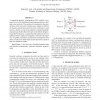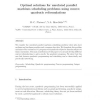AMC
2011
12 years 8 months ago
2011
:In this paper, a novel supervised dimensionality reduction method is developed based on both the correlation analysis and the idea of large margin learning. The method aims to m...
ICASSP
2011
IEEE
12 years 8 months ago
2011
IEEE
A sequential quadratic programming (SQP) method is proposed to solve the distributed beamforming problem in multiple relay networks. The problem is formulated as the minimization ...
CORR
2011
Springer
12 years 11 months ago
2011
Springer
Quadratic Programming (QP) is the well-studied problem of maximizing over {−1, 1} values the quadratic form i=j aijxixj. QP captures many known combinatorial optimization proble...
SIAMSC
2010
13 years 2 months ago
2010
A recursive acceleration method is proposed for multiplicative multilevel aggregation algorithms that calculate the stationary probability vector of large, sparse, and irreducible ...
SIAMJO
2010
13 years 2 months ago
2010
Abstract. Sequential quadratic programming (SQP) methods form a class of highly efficient algorithms for solving nonlinearly constrained optimization problems. Although second deri...
SIAMJO
2002
13 years 4 months ago
2002
Given an undirected graph with positive weights on the vertices, the maximum weight clique problem (MWCP) is to find a subset of mutually adjacent vertices (i.e., a clique) having ...
AUTOMATICA
2002
13 years 4 months ago
2002
Conventional MPC uses quadratic programming (QP) to minimise, on-line, a cost over n linearly constrained control moves. However, stability constraints often require the use of la...
NN
2008
Springer
13 years 4 months ago
2008
Springer
This paper presents two k-winners-take-all (k-WTA) networks with discontinuous activation functions. The k-WTA operation is first converted equivalently into linear and quadratic ...
EOR
2010
13 years 4 months ago
2010
We consider the unrelated parallel machines scheduling problem where jobs have earliness and tardiness penalties and a common due date. We formulate this problem and some of its v...
DAC
2006
ACM
13 years 10 months ago
2006
ACM
This paper investigates methods for clock skew minimization using buffer and wire sizing. First, a technique that significantly improves solution quality and stability of sequent...




